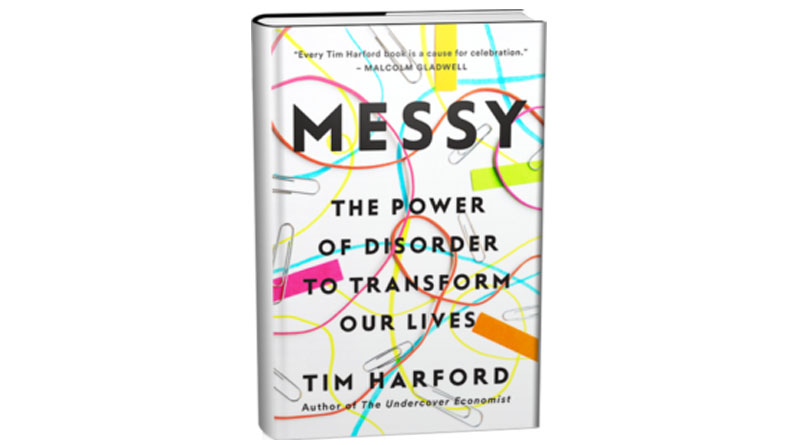Messy: How to be Creative and Resilient in a Tidy-Minded World
Messy: How to be Creative and Resilient in a Tidy-Minded World is a book about the value of messiness in our lives. It is a mix of science and inspiring stories and a most enjoyable read. So much so I blogged about this before even finishing the book.
Fous is key, right?
We all know that good work comes from focus. We know focus can be impacted by distractions. Therefore distractions are clearly a bad thing. The rise of big data is part of the human drive to impose order on the world. But where does this leave creativity?
Academic studies have shown that people who have weak attentional filters are more creative (and achieve more) than people who are adept at blocking out distractions. Tim Harford asserts that people with ADHD are more creative than others (but sadly on the audiobook, there were no details of the measures used to define this).
Breaking out of a rut
When searching for the highest peak in a mountain range it is easy to get stuck at a local optimum. A high point in that part of the mountains from where all paths lead down but to get higher we need to take this counter-intuitive step. Creativity will help make leaps to other spots which may prove beneficial. A willingness to buck the trend in search of something different can be a real asset.
In January 1975 jazz pianist Keith Jarrett was faced with a problem. A mix-up by the staff left him hours before the concert with an unplayable piano. Persuaded to perform he was forced to improvise. He played standing to get some volume from the small piano. He avoided the tinny upper registers and played rolling riffs to cover the poor resonance. The recording made that night, on the unplayable piano, sold more than 3.5 million copies and is the best-selling piano album ever.
Disruptions can force us to consider new, creative, approaches. When everything is in order there is no need to do anything other than the tried and tested. When faced with a challenge it is time to start improvising.
Benefits of Switching
I’ve blogged before on the myth of multitasking. Trying to do two things at once is a recipe for poor performance at both. However, unitasking and having multiple projects on the go is a good thing. When you hit a block in one project you can work on another and your mind can keep subconsciously trying to solve the block. In addition, if you are alert when switching between projects can bring failures from one domain to create success in other areas.
The downside of automation and optimisation
In more misadventures of assistive tech, I covered the fact that some automation is a hindrance. Messy covers this too. How many phone numbers can you remember? I’m guessing not many as they are stored on your phone. This is a powerful assistance but as a consequence, we can no longer perform a task we used to be able to.
For remembering phone numbers this is not an issue. With plane autopilot the consequences are much higher. If most of the time spent flying is ensuring the autopilot is OK there is a massive loss of practice. When something unexpected happens and the human needs to take over they don’t have the experience to step in.
More relevant examples for most of us are calendar management and email management. Research shows that meticulously organising email is counterproductive. It takes longer than searching and makes things hard to find. Optimally planning the whole day leaves no time to respond to the unexpected resulting in chaos when the inevitable happens.
The power of strong ties
We all know a high performing team need to be a tight-knit unit. In 1519 conquistador Hernan Cortes destroyed his ships on landing on an unknown shore. This forced his men to face the mighty Aztec Empire. Olympic rowing is a sport where the team must function as a unit. Consequently, the British 8 crew used strategic isolation to facilitate team unity.
The Strength of Weak Ties
Hungarian mathematician Paul Erdos was a serial collaborator. At his peak, he would turn out a new paper every 6 weeks with what was previously a complete stranger. Through working with many different people Paul was benefiting from the strength of weak ties. This is a concept coined by sociologist Mark Granovetter where random leaps are bridged by social capital.
Post-it note makers 3m have a flexible attention policy and encourage staff rotation every few years in a bid to grow innovation. This is to create the right conditions for creativity to flourish.
Group Diversity
Cognitive diversity is essential for creativity. it is an antidote to group think (individual abdication of responsibility in a like-minded group). Diversity trumps ability. If everyone thinks the same way everyone gets stuck in the same place This can be seen when studying group dynamics. Homogenous groups defer inputs that upset the status quo. Diverse groups more open to challenge
As a result, diverse perform better, but homogenous groups perceive they do better. Cohesion is comfortable, disruption is not enjoyed and the benefits are often overlooked
Bonding and Bridging
Most tasks require a mix of bonding (strong ties) and bridging (weak ties). Flashes of inspiration to identify the right approach and then hard graft with selfless teamwork to put it into practice. Getting the best balance can be challenging.
4 steps to bridging
1) Recognise the tendency to be homogenous and seek to combat it
2) Place value on people who connect teams – knitters
3) Remind yourself of the value & benefit of tension – creativity through dissonance
4) Goal harmony vs team harmony – unifying nature of a common problem to solve.

